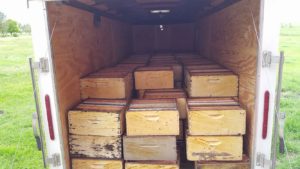May 28th – More Equipment, Split Prep
This past week I rented a trailer to pick up 120 drawn comb supers I had ordered earlier this year. This is a big jump for me as I am now set up to run 150 to 200 colonies, from the 63 we ran at the peak of last season.

These supers though in used condition still have some life left in them, the prior owner wax dipped them before selling, which adds life and value to the equipment.
I have visited the facilities of several producers which run more than 1000 colonies over the past 4 years, and always am in awe of what they have accomplished. This was the largest facility I have been to yet.

Thousands of supers stacked high are just one indication of the passion for beekeeping held by this family run operation
Upon finishing loading the “new to me” honey supers, I was offered a tour of the facility. I know that I need to build something that will pass CFIA (Canadian Food Inspection Agency) certification to extract my own product which can be sold at a retail or wholesale level. (I am repeatedly nagged about my progress on this by beekeepers that follow this blog, it is good to know i have their support, and they push me to be the best I can be.) This was a real treat to me, this particular beekeeper also runs a wax rendering facility, which was very interesting to see. I received many ideas, and suggestions for my future facility.
One of the things that makes me proud to be a beekeeper, is the hospitality and, for the most part respect that beekeepers afford one another. We got to talking bees for the next couple hours, and I was invited in to share lunch with the family, after a long drive in, it was not necessary but very much appreciated. I like to invite visiting beekeepers in for a meal or drink as well, and it is nice to see others share that same sense of hospitality. As a Mennonite it is a given, that when you care for someones well-being, you show it by feeding them!
Another thing that was great to see was even in success, these commercial beekeepers still have that same passion for keeping bees that I currently have. They have poured everything into the well-being of the livestock, and in turn the bees have afforded them a living. Testing and treating for diseases, and monitoring bee health is at the top of the list for nearly every successful beekeeper I know. Healthy bees, make more honey, more honey means more money! It just makes sense to put the health of your bees before profits, because profits follow healthy bees.
The rainy weather has kept me out of the hives for a few days this week, but I was able to get into the hives and ready them for Tuesday’s split. Bees are shaken off the frames of the second brood box into the bottom box, and then a queen excluder is placed between the two. We wish to prevent the existing queen from being on the frames which we will be moving out into the splits.
By shaking down the bees below the excluder, we ensure the queen is in the bottom box, also the nurse bees, which are young and have not yet left the hive will move back up onto the separated brood. These bees will remain on the frames to take care of the new colony when split. Doing this all before the split, I can feel comfortable focusing on only the amount of brood needed and food stores for the new split hives on Tuesday, knowing which boxes have surplus brood, and that I have enough brood available for the splits i have planned. The queen meanwhile will continue laying in the bottom box as if nothing happened, these split colonies should not swarm, and will make a healthy crop of honey for me this season.
Next week I will share info about the split, the equipment I use and my plan for these new hives, hopefully I can get some good photos to help understand the process.

Leave a Comment